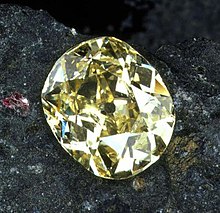Diamonds with their inimitable sparkle and brilliance have been coveted for thousands of years. The first diamond mines were in India, where the famed Golconda mines were renowned for their particularly fine gems. Diamonds were traded in India for many centuries, with some historians hypothesizing that diamonds were being traded in India since the 4th century BC. Their limited supply made diamonds very expensive and they were worn mostly by the elite in India. However, by the 1400s diamonds had found their way to Europe where the shimmering gems became very popular, despite, or perhaps because of, their scarce supply.
By the early 1700s the diamond supply in India was pretty much tapped out, but luckily a new source of diamonds was found in Brazil by miners who were panning for gold in rivers, but were also finding diamonds. These stones, known as alluvial diamonds, are diamonds that are found in riverbeds, shorelines and the ocean floor. They came to the earth’s surface mostly through millions of years of erosion of the kimberlite rock that originally housed the gems. Brazil remained the primary source of diamonds for around the next 150 years. Then, in the mid 1800s a chance find on a farm in South Africa led to the biggest discovery of diamonds ever and ensured a steady, abundant supply of the gems.
Eureka Diamond

It started one fine day in 1866, some historians say 1867, when Erasmus Jacobs found a very cool looking rock when he was out doing chores near a riverbed on his father’s farm along the Orange River. He picked it up and took it home, thinking nothing of what he had found. A few days later a neighboring farmer, Schalk van Niekerk, came to visit. He had a penchant for stones and this one caught his eye. He liked it so much, that Erasmus’ mother gave the stone to van Niekerk, who thought there was something special about the rock. Van Niekerk eventually had the stone evaluated by an amateur gemologist, Dr. Guybon Atherstone, who concluded that the rock was indeed a 21.25-carat brownish-yellow rough diamond. The diamond was sold and the story gets a bit murky here, some sources say that van Niekerk offered half the money from the sale to the Jacobs family who turned it down, others say that no money was ever offered to the family. The diamond was eventually bought by Sir Philip Wodehouse, governor of Cape Colony in South Africa. He sent it to London and the diamond was later cut into a 10.73-carat cushion shape. The diamond stayed in England for about 100 years before De Beers purchased the stone in 1966 and returned it to South Africa, where it now lives in the Kimberley Mine Museum.
Star of South Africa
No more diamonds appeared on the Jacobs’ farm, but a similar chance event led to another diamond find, this time by a sheep herder in 1869. He was herding his flock on the Zandfontein farm, also near the Orange River, when he saw a shiny stone. He picked it up and offered it to a farmer in exchange for shelter for the night. The farmer wasn’t interested in the rock, but instead sent him to a neighbor who he knew had an interest in stones — Schalk van Niekerk. After his experience with Erasmus Jacobs’ diamond, van Niekerk was pretty sure he was looking at a diamond. According to the DeBeers Group website, In exchange for the rock, van Niekerk gave the shepherd 500 sheep, 10 cattle and a horse.
Van Niekerk then headed to Hopetown to verify that the stone was a diamond. It turned out to be an 83.50-carat rough diamond, which van Niekerk sold for 11,300 pounds. The gem was eventually cut into a pear shape weighing 47.75-carats and was purchased by the Earl of Dudley. It was named the Dudley Diamond, but is better known as the “Star of South Africa”. The diamond remained in the Dudley family until 1974 when it was sold at auction in Geneva. It’s last public appearance was at London’s Natural History Museum in 2005.
Diamond Rush
Soon after van Niekerk sold what is now the Star of South Africa, it sparked a diamond rush, with prospectors flocking to the area along the Orange River and Vaal River banks. In 1871 two brothers Johannes and Diederik DeBeer (sound familiar) bought a farm in Orange Free State where they discovered diamonds. That farm became the Kimberley Mine, one of the world’s major producing diamond mines.
British entrepreneur Cecil Rhodes arrived in the area during this time and bought up claims from other prospectors and in 1888 he founded De Beers Consolidated Mines Limited. By 1900 De Beers controlled about 90 percent of the world’s rough diamond production through its South African mines, which created a reliable and abundant supply of the icy gems. De Beers has adapted and changed throughout the years, but it still exists today and continues to be one of the companies that supplies the world with diamonds.
Featured image (top of page): Kimberley, South Africa: Miners around the Central Company’s shaft in the Kimberley mine. Woodburytype, 1888, after a photograph by Robert Harris, Wellcome Collection, Public Domain Mark.
Authored by Amber Michelle
